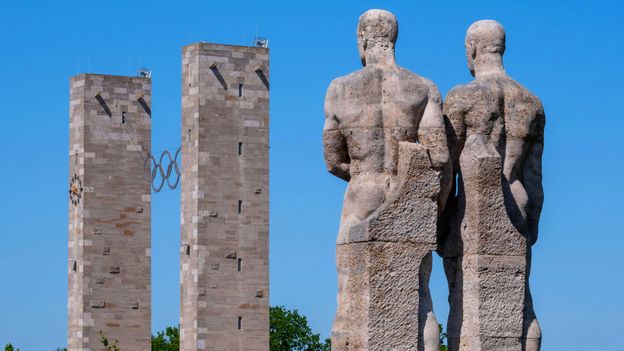What happens to fascist architecture?


“Leaving the monuments in situ allows you to contemplate the context in which they were created,” explains Di Michele, who was also a member of the cross-communal taskforce. “It creates a dialogue about them and about fascism in general, and allows us to better understand the strong urban impact of fascist architecture and the far-reaching dimensions of the artistic interventions. If you move them to a room in a museum you cannot understand what impact they were intended to have and have had on the city, on the urban and symbolic layout.”
The artistic interventions were a huge success, praised by politicians and civil society members from both communities. There are still occasional communal tensions, but not about buildings. That chapter has been closed. They even managed to neutralise the extremist rallies that were blighting the city.
“The Italian far-right used to assemble every year in front of the bas-relief and perform the fascist salute,” says Obermair. “But with the Arendt quote there, they feel humiliated. So they’ve stopped coming. Likewise, the far-right groups from the German-speaking community used to rally in front of the Victory Monument to say ‘Look how Italy is oppressing us’, but now they can no longer say that. We’ve destroyed their toys, so to speak.”
Obermair is enthusiastic that the Bolzano model could be successfully replicated in other parts of Italy, as well as in other countries struggling with divisive and complex fascist legacies, such as Spain. The model also offers a solution to the debate over statues in the UK and US. “Of course the social context in Bolzano is important, and each community needs to imagine its own artistic intervention,” says Obermair. “But the basic idea, that we shouldn’t destroy monuments but radically transform them, is a powerful one. It provides people with the tools to reflect on history, question ideology and critically examine the built environment around them. No architecture is neutral. Ultimately it is we, not the monuments, who should have the final word.”
If you would like to comment on this story or anything else you have seen on BBC Culture, head over to our Facebook page or message us on Twitter.
And if you liked this story, sign up for the weekly bbc.com features newsletter, called The Essential List. A handpicked selection of stories from BBC Future, Culture, Worklife and Travel, delivered to your inbox every Friday.








